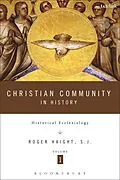Drawing upon the methodology developed in his Dynamics of Theology (1990) and exemplified in Jesus Symbol of God (1999), Roger Haight, in this magisterial work, achieves what he calls an historical ecclesiology, or ecclesiology from below. In contrast to traditional ecclesiology from above, which is abstract, idealist, and ahistorical, ecclesiology from below is concrete, realist, and historically conscious. In this first of two volumes, Haight charts the history of the church's self-understandings from the origins of the church in the Jesus movement to the late Middle Ages. In volume 2 Haight develops a comparative ecclesiology based on the history and diverse theologies of the worldwide Christian movement from the Reformation to the present. While the ultimate focus of the work falls on the structure of the church and its theological self-understanding, it tries to be faithful to the historical, social, and political reality of the church in each period.
Autorentext
Roger Haight, SJ, has a PhD from the University of Chicago (1973) and a STL from the Jesuit School of Theology in Chicago (1981). He has taught for over 30 years in Jesuit schools of theology in Chicago, Toronto, the Philippines, and Cambridge, Massachusetts. He has been a visiting professor in France, India, Peru, and Kenya. He is a past president of the Catholic Theological Society of America (1994/95). Jesus Symbol of God won 1st place in the Catholic Press Association's 2000 Book Award for theology. Dynamics of Theology won 2nd place in CPA's 1991 Book Award for Theology. His most recent work is Christian Community in History in 2 volumes. He currently teaches at Union Theological Seminary in New York City.
Klappentext
Drawing upon the methodology developed in his Dynamics of Theology (1990) and exemplified in Jesus Symbol of God (1999), Roger Haight, in this magisterial work, achieves what he calls an historical ecclesiology, or ecclesiology from below. In contrast to traditional ecclesiology from above, which is abstract, idealist, and ahistorical, ecclesiology from below is concrete, realist, and historically conscious.
In this first of two volumes, Haight charts the history of the church's self-understandings from the origins of the church in the Jesus movement to the late Middle Ages. In volume 2 Haight develops a comparative ecclesiology based on the history and diverse theologies of the worldwide Christian movement from the Reformation to the present. While the ultimate focus of the work falls on the structure of the church and its theological self-understanding, it tries to be faithful to the historical, social, and political reality of the church in each period.
Inhalt
Preface
Introduction
Part I: The Question of Method
1. Historical Ecclesiology
Part II: The Formation of the Church
2. Genesis of the Church
3. The Pre-Constantinian Church
4. The Post-Constantinian Church
5. The Gregorian Reform and the New Medieval Church
6. Conciliarism and the Late Medieval Church
Index
